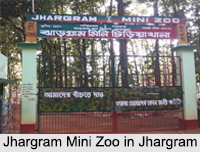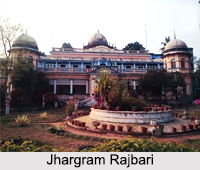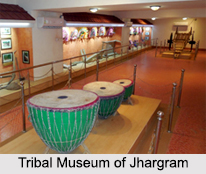 Located in the state of West Bengal, the municipality of Jhargram is the administrative headquarter of the Jhargram district. It has an average elevation of 81 metres and is part of the Chota Nagpur Plateau region beyond the Gangetic plains close to the western borders of the state. The official languages spoken here are Bengali and English. The current chairperson of the area is the eldest grandson of Raja Narasingha Malla Deb, called Raja Shivendra Bijoy Malla Deb.
Located in the state of West Bengal, the municipality of Jhargram is the administrative headquarter of the Jhargram district. It has an average elevation of 81 metres and is part of the Chota Nagpur Plateau region beyond the Gangetic plains close to the western borders of the state. The official languages spoken here are Bengali and English. The current chairperson of the area is the eldest grandson of Raja Narasingha Malla Deb, called Raja Shivendra Bijoy Malla Deb.
History of Jhargram
During the reign of Akbar, he wanted to expand the Mughal Empire from Rajasthan to the Eastern India. And to achieve that Sarveshwar Singh, one of the loyal officers of Raja Man Singh of Amber was appointed to defeat the local rulers of the region known as Junglekhand. He belonged to the Chauhan clan of Rajputs from Fatehpur Sikri in Rajasthan. Sarveshwar Singh together with the Rajput military force and cavalry invaded the deep forest and vanquished the Mal rulers. Thus, he adopted the surname Malla Deb and was the founder of the Jhargram kingdom. He took the title of Raja and named the state capital Jhargram, which means a forest village which is surrounded by walls and canals. It was known as Ugal in the local language. Even in the contemporary times, a day after Durga Asthami, the four corners or ugals are worshipped for the protection of the erstwhile kingdom. The man who was the hero or bull within the surrounded wall and canal were called Ugal Sanda. As such, the full name of the Raja of the State was known as Raja Sarveshwar Malla Ugal Sanda Deb, and the title has been continued up to Raja Narasingha Malla Ugal Sanda Deb.
During the invasion by the Marathas from 1742 to 1747, Jhargram joined forces with the Raja of Bishnupur and the Nawab of Bengal and came forth victorious in the fight. The independent stature of Jhargram ended in 1767, when the British East India Company led by Robert Clive came from Midnapore, via Radhanagar and captured the Jhargram Fort. The kingdom was then recognized as a Zamindari estate under the law of primogeniture, and the ruler was given the title of Raja. The kingdom of Jhargram fell twice into the Court of Wards, after the death of Raja Raghunath Malla Ugal Sanda Deb and Raja Chandi Charan Malla Ugal Sanda Deb, respectively. Jhargram was later released when the Raja Narsingha Malla Deb attained majority, who was considered to be the father of modern Jhargram.
The period between 1992 and 1950 is known to be the golden age of Jhargram under the administration of Prof. Debendra Mohan Battacharya. In those 28 years, Jhargram developed into a township and many educational institutions were established and developed. He also created an annual sports fund, which was used to encourage the sports activities and construct the Jhargram football stadium. Alongside him, the contributions of Raja Narsingha Malla Deb were also immense like the establishment of agricultural and polytechnic colleges. He also contributed to welfare causes and donated 10,000 bighas of land to poor farmers in 1947, making him the single largest land donor in West Bengal.
 Climate of Jhargram
Climate of Jhargram
The climate of Jhargram is similar to that of Bengal"s with an extremely hot and humid tropical weather. The major part of the town is covered by lateritic soil, while facets of alluvial deposit are found in the northern part. The soil is reddish-brown in colour.
The area is prone to drought since it is on the rain-shadow area and the annual average rainfall received here is 1000mm, which is much lower than the other parts of the district. During the summer season, between the hot dry months of May and June, the temperature rises up to 46° C. During the chilly winter months of December and January, there is a noticeable plummet in the temperature to 4° C..
Demographics of Jhargram
As per the reports of Census India 2011, the Jhargram municipality has a total population of 61,712 out of which 30,876 are males while 30,836 are female. The population of children between the ages of 0 to 6 years is 5,382 which is basically 8.72% of the total population. The female sex ratio is 999 against the state average of 950. The literacy rate of Jhargram is 88.53% which is higher than the state average of 76.26%. The Jhargram municipality has total administration over 14,235 houses to which it supplies basic amenities like water and sewerage.
Culture of Jhargram
Jhargram is a treasure trove of tribal dances like Chuang, Chang, Chou, Dangrey, Jhumur, Panta, Ranpa, Saharul, Tusu & Bhadu etc. Besides the tribal culture, the regular Bengali festivals like Durga Puja, Saraswati Puja, Diwali and Kali Pujas are well attended along-with other festivities. A lot of fairs and carnivals also take place in this area. The famous fairs in Jhargram are Jungle Mahal Utsav, Jhargram Mela & Yuva Utsav, Rong Maati Manush, Shrabani Mela, Baishakhi Mela and Milan Mela.
Popular Attractions of Jhargram
Jhargram is a popular tourist destination, listed below are few of the popular attractions of the area.
Jhargram Raj Palace: The current residence of the Malla Deb Royal family, the Jhargram Raj Palace is a structure combining the Gothic and Muslim architectural modals. Built in 1931, this Palace was designed by the Kolkata Improvement Trust during the reign of Raja Narsingha Malla Deb Bahadur. The Palace campus is so evocative of a regal lifestyle, the past comes alive. It has been a host to many dignitaries since its inception.
Jhargram Mini Zoo: A congenital park, located about 2 km from Jhargram, where the animals seem to be out in their natural livelihood. The zoo is also known as the Deer Park.
 Eco-Tourism Centre and Tribal Museum: The Jhargram eco-tourism centre is a beautiful forest retreat located about 5 km outside of Jhargram. Here, there is also a tribal museum displaying the indigenous tribal culture of the district and tribal folk performances are a weekend entertainment.
Eco-Tourism Centre and Tribal Museum: The Jhargram eco-tourism centre is a beautiful forest retreat located about 5 km outside of Jhargram. Here, there is also a tribal museum displaying the indigenous tribal culture of the district and tribal folk performances are a weekend entertainment.
Chilkigarh Raj Palace and Kanak Durga Temple: The Kanak Durga Temple was built under the patronage of King Samanta, here Goddess Durga is worshipped in the form of Kanak Durga and she is known to be the ancestral deity of the Chilkigarh Royal family. The Dulung River flows between the temple and the Raj Palace of Chikligarh. The area is surrounded by 375 different and unique species of plants. With a vibrant wildlife consisting of monkeys and poisonous snakes, the place is given a natural ambience of a forest.
Kendua: The village of Kendua is a popular centre for bird watching. Migratory birds fly here in the month of May, which indicate the commencement of the monsoon season. By mid November these birds fly away, thus marking the end of the migration season.
Sabitri Temple: Almost 350 years old, the Sabitri Temple is possibly the oldest structure in Jhargram. Goddess Sabitri is the ancestral deity of the Malla Deb family and is worshipped in the form of Durga. Idol worshipping is not done in this temple; instead there is a stone that is believed to have the divine embodiment of the Goddess. There are many fables and myths surrounding the temple among the people of the area.
Visiting Information on Jhargram
The closest airports to Jahragram are the Netaji Subhas Chandra Bose International Airport at Kolkata and the Sonari Airport at Jamshedpur. Jhargram has its own railway station which is on the Kharagpur-Tatanagar section of Howrah-Nagpur-Mumbai line, which is an express train route. And by roadways, Jhargram is well connected as it lies on the Asian Highway Network 6 and is close to all the nearby cities.






